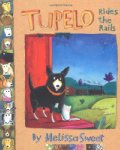Many of us spend a great deal of time and energy looking for a place that we can call home. Often what we are really looking for are the right people, the people who can make anyplace a home for us because they are there. Today's picture book tells the story of a dog who is looking for a place to call her own. It is a sweet and life affirming story that will resonate with readers of all ages.
 Tupelo Rides the Rails
Tupelo Rides the Rails
 Tupelo Rides the Rails
Tupelo Rides the Rails
Melissa Sweet
Picture Book
For ages 5 to 7
Houghton Mifflin Harcourt, 2008, 978-0-618-71714-9
One day Tupelo’s humans dump her, and her sock toy, on
the side of the road. Tupelo cannot understand why they would do such a thing,
and does not know where she should go next. Not being the kind of dog who gives
up, and believing that “Everyone belongs somewhere,” Tupelo picks up her toy,
Mr. Bones, and she sets off to find her place.
At first none of
the animals she encounters is interested in having her join “their tribe,” but
then Tupelo picks up the whiff of something wonderful. She follows the scent
and comes across a pack of dogs that are taking part in a bone-burying ritual.
They all make a wish to Sirius, the Dog Star, and then bury a bone as an
offering to him. The dogs believe that the ritual will bring them “good luck
and fortune.”
Under the
glimmer of Sirius the dogs all make their wishes and then bury their bones. All
of them except Tupelo. She has no bone to bury and she cannot bear to bury Mr.
Bones. Instead of wishing, Tupelo decides to follow the dog pack. The dogs are
fed by a hobo called Garbage Pail Tex and then the man and all the dogs hop on
a train. The hobo tells the dogs about famous dogs from history, dogs like
Lassie and Toto. He sings them a bedtime song too, and Tupelo wishes that the
ride will “last forever.”
When they arrived
in Hoboken, Garbage Pail Tex and some of his hobo friends set about reuniting
the lost dogs with their families, and finding homes for the others. One by one
the dogs go off to be with people who will love and cherish them. Finally, Tupelo
is the only one left and she is alone once more with no one for company except
Mr. Bones.
In this lovely
story about a dog who is looking for a home, Melissa Sweet combines her
charming multimedia artwork with a narrative that readers of all ages will
love. Anyone who has felt lost and alone at some point will appreciate how
Tupelo feels as she tries to find her place.







